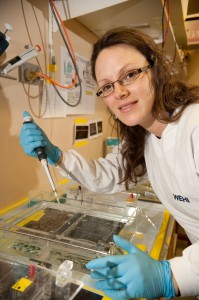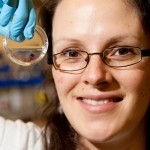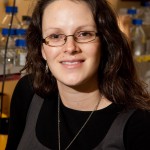Marnie Blewitt
The Walter & Eliza Hall Institute of Medical Research, Melbourne

“How does a cell know which of its 30,000 or so genes should be active and which should be dormant?” says Marnie, a researcher at the Walter and Eliza Hall Institute of Medical Research.
“How does the keratin gene get turned on in hair follicle cells but not in the cells of the eye? And what happens when the switching goes wrong?”
“We know it all starts with the genes,” she says. “The human genome project revealed the blueprint. But how does each cell know which genes to use, and which ones to ignore?”
The key she says is in the punctuation-the genome is labelled with tags and flags to indicate which genes are active and which are not. This ‘epigenetic’ information is what seems to guide the cell to turn on and turn off genes.
Marnie is using the X chromosome to try to understand epigenetics. The X chromosome is unusual because in males there is only one copy of this chromosome, while in females there are two copies. One of these copies has to be turned off for normal development.
“The second copy of the X chromosome has to be completely inactivated. We know it is packaged away and silenced through a number of steps during development from a fertilised egg into an adult. I’m using it as a model system to help unravel the complex story of epigenetic control,” says Marnie.
(Video production: Jerome Pelletier, Stepping Stone Pictures)
Using this system, Marnie says she can rapidly look at the 1,200 or so genes that are thought to be part of the switching system. “Within a couple of years we should have some exciting new leads to follow up,” she says.
Marnie hopes her research will lead to some fundamental insights into how epigenetics controls the expression of the genes. It may also have some important application to disease.
“When epigenetics goes wrong it can cause cancer,” Marnie says. “If we can understand the molecular mechanisms then perhaps we can design targeted therapies to treat these tumours in the most effective ways possible.”
Marnie says the L’Oréal For Women In Science Fellowship will allow her to maintain the pace of her research project by funding a research assistant to be her ‘hands’ in the laboratory while she is on maternity leave, and by assisting with the cost of childcare once she returns to work.
“The Fellowship comes at the perfect time in my career, giving me the support I need to stay in science while starting my family.”
Background
Qualifications
2004 PhD (Molecular and Microbial Biosciences), University of Sydney
1999 Bachelor of Science, First Class Honours, University of Sydney
Career highlights, awards, fellowships and grants
2009 Australian Academy of Science Ruth Stephens Gani Medal, for human genetics
2008- Senior Research Officer, Hilton Laboratory,
Walter and Eliza Hall Institute of Medical Research, Melbourne
2008 National Health and Medical Research Council grant:
The role of Smchd1 in X inactivation
2007 National Health and Medical Research Council grant:
Molecular Regulation of Blood Cell Production and Function, Co-investigator
2006 National Health and Medical Research Council fellowship:
Walter and Eliza Hall Institute of Medical Research, Melbourne
2005 DG Catcheside Prize for Best PhD in Genetics for 2005,
Genetics Society of Australia
2005-2008 Postdoctoral Research Fellow, Hilton Laboratory,
Walter and Eliza Hall Institute of Medical Research, Melbourne
2005 Postdoctoral Researcher, Whitelaw Laboratory, School of Molecular and Microbial Biosciences, University of Sydney
2000-2001 Research Assistant in Dr Trevor Biden’s laboratory,
Garvan Institute of Medical Research
1999 University Medal, University of Sydney
Research highlights
- More than 25 presentations at Australian and international conferences and institutions including six invited conference presentations
- Ten journal articles and reviews including four as first author, and one book chapter
- Three visits to international laboratories to collaborate and learn new techniques
- One patent application
- Editorial and peer review for a variety of journals and grants
- Developed a mutagenesis screen for epigenetic modifiers in mice
- Identified certain genes involved in inactivating the X chromosome
Alternative images:
video: Jerome Pelletier, www.steppingstone.com.au


